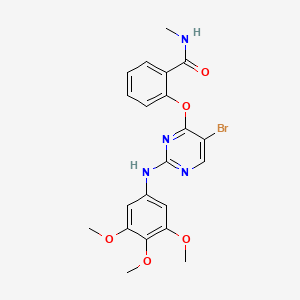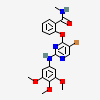Sbi-0206965
- SBI-0206965
- 1884220-36-3
- Sbi0206965
- 2-((5-Bromo-2-((3,4,5-trimethoxyphenyl)amino)pyrimidin-4-yl)oxy)-N-methylbenzamide
- 2-[5-bromo-2-(3,4,5-trimethoxyanilino)pyrimidin-4-yl]oxy-N-methylbenzamide
- Create:2015-11-16
- Modify:2025-01-11

- SBI-0206965
- 1884220-36-3
- Sbi0206965
- 2-((5-Bromo-2-((3,4,5-trimethoxyphenyl)amino)pyrimidin-4-yl)oxy)-N-methylbenzamide
- 2-[5-bromo-2-(3,4,5-trimethoxyanilino)pyrimidin-4-yl]oxy-N-methylbenzamide
- 2-({5-bromo-2-[(3,4,5-trimethoxyphenyl)amino]pyrimidin-4-yl}oxy)-N-methylbenzamide
- 2-({5-bromo-2-[(3,4,5-trimethoxyphenyl)amino]pyrimidin-4-yl}oxy)-N-methylbenzene-1-carboximidic acid
- 2-((5-Bromo-2-((3,4,5-trimethoxyphenyl)amino)pyrimidin-4-yl)oxy)-N-methylbenzamide;
- 2-(5-bromo-2-(3,4,5-trimethoxyanilino)pyrimidin-4-yl)oxy-N-methylbenzamide
- EDJ
- MFCD29472244
- CHEMBL4128069
- SCHEMBL17544844
- SCHEMBL26708417
- GTPL11339
- EX-A747
- BDBM379177
- BCP23859
- BCP29511
- US10266549, Example 88
- NSC784816
- s7885
- US10266549, Example 171a
- AKOS027328490
- CCG-269603
- CS-5016
- NSC-784816
- NCGC00481542-04
- AC-32934
- AS-56287
- BS170577
- DA-77725
- HY-16966
- SBI-0206965?
- SBI0206965; SBI 0206965
- SBI-0206965, >=98% (HPLC)
- 2-(5-Bromo-2-(3,4,5-trimethoxyphenylamino)pyrimidin-4-yloxy)-N-methylbenzamide
- 2-[[5-Bromo-2-[(3,4,5-trimethoxyphenyl)amino]-4-pyrimidinyl]oxy]-N-methyl-benzamide

H315 (100%): Causes skin irritation [Warning Skin corrosion/irritation]
H319 (100%): Causes serious eye irritation [Warning Serious eye damage/eye irritation]
H335 (100%): May cause respiratory irritation [Warning Specific target organ toxicity, single exposure; Respiratory tract irritation]
P261, P264, P264+P265, P271, P280, P302+P352, P304+P340, P305+P351+P338, P319, P321, P332+P317, P337+P317, P362+P364, P403+P233, P405, and P501
(The corresponding statement to each P-code can be found at the GHS Classification page.)
Skin Irrit. 2 (100%)
Eye Irrit. 2 (100%)
STOT SE 3 (100%)
Patents are available for this chemical structure:
https://patentscope.wipo.int/search/en/result.jsf?inchikey=NEXGBSJERNQRSV-UHFFFAOYSA-N
- ChEMBLLICENSEAccess to the web interface of ChEMBL is made under the EBI's Terms of Use (http://www.ebi.ac.uk/Information/termsofuse.html). The ChEMBL data is made available on a Creative Commons Attribution-Share Alike 3.0 Unported License (http://creativecommons.org/licenses/by-sa/3.0/).http://www.ebi.ac.uk/Information/termsofuse.htmlChEMBL Protein Target Treehttps://www.ebi.ac.uk/chembl/g/#browse/targets
- European Chemicals Agency (ECHA)LICENSEUse of the information, documents and data from the ECHA website is subject to the terms and conditions of this Legal Notice, and subject to other binding limitations provided for under applicable law, the information, documents and data made available on the ECHA website may be reproduced, distributed and/or used, totally or in part, for non-commercial purposes provided that ECHA is acknowledged as the source: "Source: European Chemicals Agency, http://echa.europa.eu/". Such acknowledgement must be included in each copy of the material. ECHA permits and encourages organisations and individuals to create links to the ECHA website under the following cumulative conditions: Links can only be made to webpages that provide a link to the Legal Notice page.https://echa.europa.eu/web/guest/legal-notice2-(5-bromo-2-(3,4,5-trimethoxyphenylamino)pyrimidin-4-yloxy)-N-methylbenzamide (EC: 861-948-6)https://echa.europa.eu/information-on-chemicals/cl-inventory-database/-/discli/details/308737SBI-0206965 (EC: 998-873-4)https://echa.europa.eu/information-on-chemicals/cl-inventory-database/-/discli/details/3859442-(5-bromo-2-(3,4,5-trimethoxyphenylamino)pyrimidin-4-yloxy)-N-methylbenzamidehttps://echa.europa.eu/substance-information/-/substanceinfo/100.313.830SBI-0206965https://echa.europa.eu
- IUPHAR/BPS Guide to PHARMACOLOGYLICENSEThe Guide to PHARMACOLOGY database is licensed under the Open Data Commons Open Database License (ODbL) https://opendatacommons.org/licenses/odbl/. Its contents are licensed under a Creative Commons Attribution-ShareAlike 4.0 International License (http://creativecommons.org/licenses/by-sa/4.0/)https://www.guidetopharmacology.org/about.jsp#licenseGuide to Pharmacology Target Classificationhttps://www.guidetopharmacology.org/targets.jsp
- PharosLICENSEData accessed from Pharos and TCRD is publicly available from the primary sources listed above. Please respect their individual licenses regarding proper use and redistribution.https://pharos.nih.gov/about2-(5-bromo-2-(3,4,5-trimethoxyphenylamino)pyrimidin-4-yloxy)-N-methylbenzamidehttps://pharos.nih.gov/ligands/SFAK8VHB3T5B
- Protein Data Bank in Europe (PDBe)
- RCSB Protein Data Bank (RCSB PDB)LICENSEData files contained in the PDB archive (ftp://ftp.wwpdb.org) are free of all copyright restrictions and made fully and freely available for both non-commercial and commercial use. Users of the data should attribute the original authors of that structural data.https://www.rcsb.org/pages/policies
- PubChem
- Medical Subject Headings (MeSH)LICENSEWorks produced by the U.S. government are not subject to copyright protection in the United States. Any such works found on National Library of Medicine (NLM) Web sites may be freely used or reproduced without permission in the U.S.https://www.nlm.nih.gov/copyright.htmlSBI-0206965https://www.ncbi.nlm.nih.gov/mesh/2009113
- GHS Classification (UNECE)GHS Classification Treehttp://www.unece.org/trans/danger/publi/ghs/ghs_welcome_e.html
- MolGenieMolGenie Organic Chemistry Ontologyhttps://github.com/MolGenie/ontology/
- PATENTSCOPE (WIPO)SID 395735060https://pubchem.ncbi.nlm.nih.gov/substance/395735060

